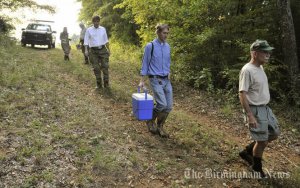Josh Holmes of Alabama Land Trust, Inc. was one of the volunteers helping the Alabama Aquatic Biodiversity Center with the release of rare mussels into Choccolocco Creek on Thursday, Sept. 30.

Josh Holmes of Alabama Land Trust, second from right, carries a cooler full of Alabama Rainbow mussels as a volunteer for the Alabama Aquatic Diversity Center's reintroduction project on Choccolocco Creek Sept. 30 near Talladega. Photo from The Birmingham News website.
Holmes, other volunteers and biologists from the Marion, Ala.-based state-sponsored biodiversity center carefully planted 1,300 penny-sized and number-and-color-coded mussels among rocks and pebbly sand on the bottom of Choccolocco Creek in northeast Alabama. Another 300 gastropods were planted upstream by other volunteers. In addition to the large collection of Alabama Rainbow mussels, the center also brought along for planting into the creekbed some fine-lined pocketbook mussels, Alabama creek mussels and rough-horn snails.
The mussels and snails were cultured at Alabama Aquatic Biodiversity Center as part of a recovery effort aimed at saving and restoring dozens of endangered aquatic species and restoring the quality of state waters.
Center director Dr. Paul Johnson points out that mussels are natural water filters, which filter out bacteria and organic matter from passing water, and snails eat on biofilm, bacteria and algae.

Alabama Rainbow mussels were numbered and color coded to help with identification after the reintroction into Choccolocco Creek. Photo from The Birmingham News website.
Alabama Land Trust is collaborating with the center in the reintroduction, survey and monitoring of the mussels and other gastropods in Choccolocco Creek, where Alabama Land Trust protects more than 780 acres in the watershed and more than 10 miles of actual creek footage. Having land in the Choccolocco Creek watershed which is permanently protected with conservation easements helps with the success of the mussel and snail reintroductions and survival. Land protected by conservation easements provides large riparian buffers that safeguard water quality and habitat and prohibit floodplain development. Eventually, Alabama land Trust will coordinate with the aquatic biodiversity center on making protected land available for gastropod surveys and monitoring and any future mussel and snail reintroductions.
Read and see more about the Alabama Aquatic Diversity Center’s efforts and this week’s activities in articles in The Birmingham News, at: http://blog.al.com/spotnews/2010/10/mussels_returned_to_alabamas_c.html,
and The Anniston Star, http://www.annistonstar.com/
See more pictures from The Birmingham News gallery at his link:
http://photos.al.com/4461/gallery/alabama_rainbow_mussels_introduced_to_choccolocco_creek/index.html

Leave a comment